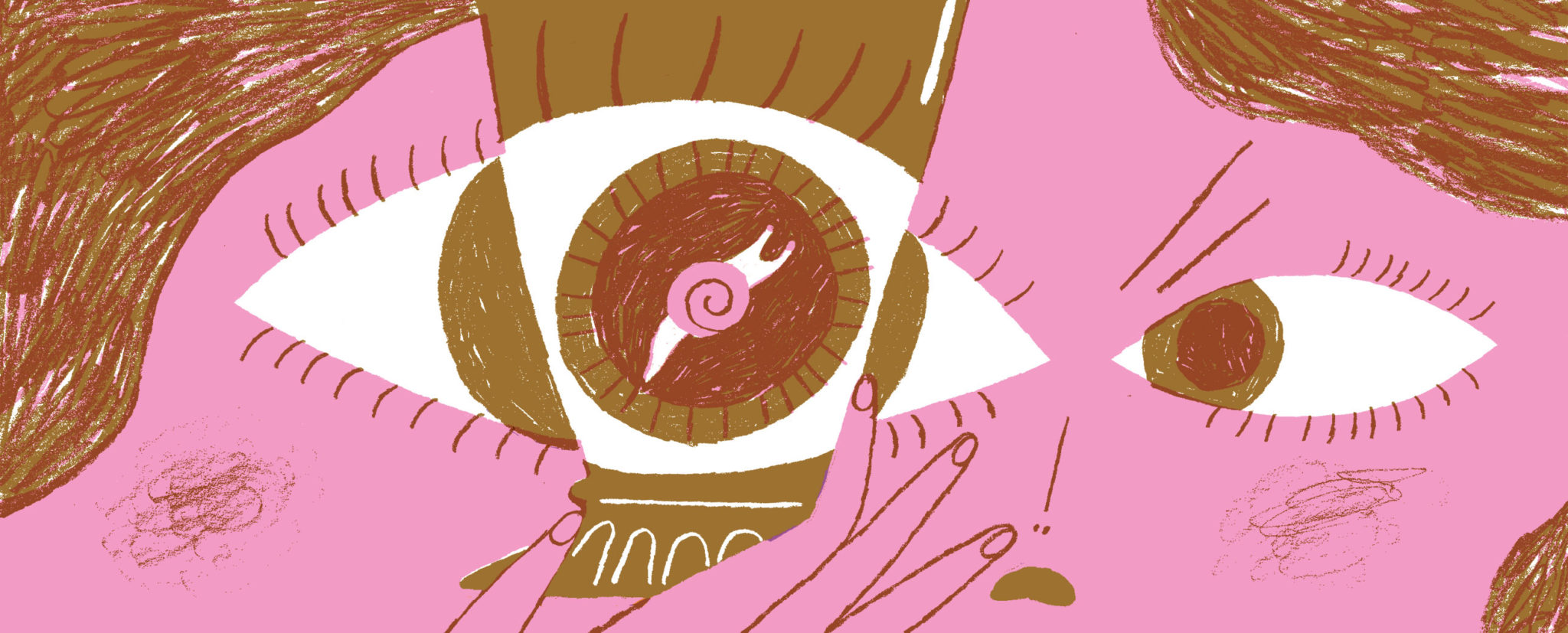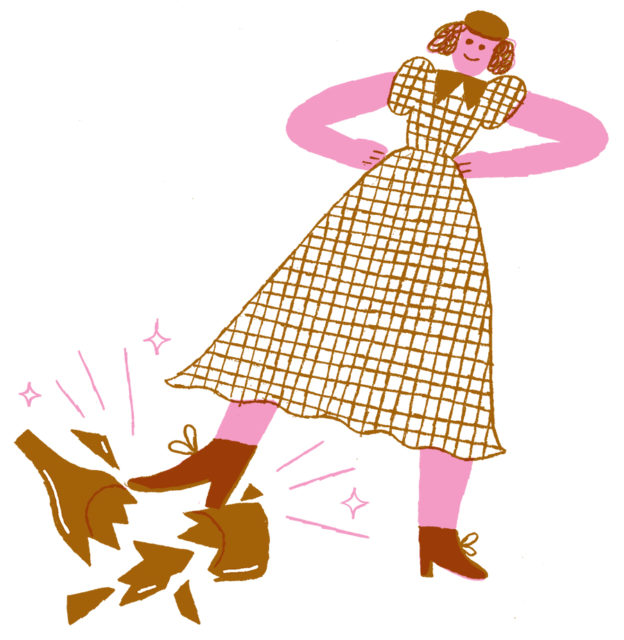
Illustrations by Min Heo.
May Donoghue was not the weak-natured type.
Growing up with little and losing three babies in their infancy, Donoghue had overcome a lifetime’s worth of hardships by the time she was 30. But she was not prepared for the snail.
Donoghue spied the decomposing gastropod, mixed with bits of ice cream, bobbing in a glass of ginger beer that she had been sipping at the Wellmeadow Café in Paisley, a small Scottish town not far from where she grew up. The sight of it would continue to haunt the Scottish woman for years to come.
When Donoghue and her friend complained about the snail to Wellmeadow Café owner Francis Minghella, they received barely a shrug and “well, it happens” in response. Donoghue wrote down the name of the ginger beer producer — Stevenson — and left.
Three days after finding bits of dead mollusk in her drink, Donoghue visited a doctor for sharp pains shooting in her stomach.
Three weeks later, she was hospitalized at the Glasgow Royal Infirmary with severe gastroenteritis and shock.
Donoghue’s next steps — seeking out a lawyer and filing a claim against both Minghella and David Stevenson, the owner of the company that made the ginger beer — were not exactly typical for people of her background. Lawyers were for wealthy people. Donoghue, the daughter of a steelworker, was the second youngest of six and worked as a shop assistant.
Had it happened today, the incident would have made national news and likely earned Donoghue a large compensation check. But she found the snail on August 26, 1928 — long before high-profile personal-injury lawsuits against companies like McDonald’s and Ford were the norm rather than the exception.
Most Scottish lawyers of the day would have told Donoghue that she did not have a fighting chance of winning the suit. Personal-injury laws only applied to the person who had purchased the defective product, and it was Donoghue’s friend, not her, who had paid for the ginger beer. The only exceptions were if the product was inherently dangerous or if the producer had misled the customer into thinking it was safe while knowing that it wasn’t. In either case, the ginger beer did not qualify.
But as it happened, Donoghue came across a solicitor, Walter Leechman, who had worked on but lost several similar cases, and he agreed to help her fight the law. To him, it was a matter of principle — Leechman agreed to represent Donoghue pro bono.
After nearly a year of preparing documents and going through legal books, Leechman and Donoghue filed a lawsuit asking for £500 in damages and £50 in court fees. The sum, worth approximately £35,000 ($45,000) in today’s money, was considered extravagantly large.
As with many personal-injury cases today, the matter became about much more than the incident itself — and it came at great personal cost to Donoghue.
* * *
By the time the case arrived in court, people in Glasgow had already started to talk about it. Many questioned Donoghue’s motives and attacked her character: Some said that she was doing it for the money, while others claimed she merely wanted attention. Donoghue’s separation from her husband, whom she had recently left after he’d had several affairs, was also wielded against her and used as evidence of her untrustworthiness.
“Mrs. Donoghue was a married woman, but in the case, she is portrayed as going out with a ‘friend’ for ice cream and ginger beer,” says Erika Chamberlain, the dean of the law faculty at the University of Western Ontario. Chamberlain wrote her doctoral dissertation on the case, which went down in legal history as Donoghue v. Stevenson. “There was a lot of speculation as to whether the ‘friend’ was in fact a lover.”

Details about Donoghue’s personal life — her working-class childhood, her unhappy marriage to Henry Donoghue — were dissected in the press. She was often portrayed as crazy or a liar. According to Chamberlain, one defense lawyer tried to claim that the snail never even existed.
Nonetheless, Donoghue pressed on.
“I vomited repeatedly, and suffered from acute pain in my stomach, and from mental depression,” Donoghue told the courtroom during the trial. “I was rendered unfit for my employment. I lost wages and incurred expense as the result of that illness.”
“The alleged injuries are grossly exaggerated,” wrote ginger beer manufacturer David Stevenson in one of his defenses. “Any illness suffered by the [claimant] was due to the bad condition of her own health at the time.”
And yet, the Scottish courts sided with Donoghue. While Minghella, the cafe owner, was dropped as one of the defendants before the case made it to a judge, Lord Alexander Moncrieff ruled that Stevenson had a duty to protect whomever consumed his products.
“Tainted food when offered for sale is, in my opinion, amongst the most subtly potent of ‘dangerous goods’, and to deal in or prepare such food is highly relevant to infer a duty,” Moncrieff wrote in his judgment. “I fail to see why the fact that the danger has been introduced by an act of negligence and does not advertise itself, should release the negligent manufacturer from a duty, or afford him a supplementary defense.”
Things did not end there. Stevenson appealed the decision, and Donoghue appealed his appeal. The case went all the way to the House of Lords (the highest court in the United Kingdom), and on December 10, 1933, Lord James Richard Atkin cited the Christian principle of “loving thy neighbor” in ruling that Stevenson had indeed wronged Donoghue by allowing the snail to enter the bottle.
“You must take reasonable care to avoid acts or omissions which you can reasonably foresee would be likely to injure your neighbor,” wrote Atkin in his ruling.
This principle of “duty of care” — the responsibility that a manufacturer has to make sure his product is safe for those who will be buying or consuming it — is still cited as precedent in personal-injury cases across the United Kingdom and Canada today. In the United States, the case is taught in law schools alongside American cases such as MacPherson v. Buick Motor Co., in which a man who had just bought a new car was injured when one of the wheels collapsed.
While the case has entered legal lore, it is not immediately clear why Donoghue was so determined to see the issue to its end.
Going to court caused her embarrassment and cost money she didn’t have — to even have her case heard without paying prohibitive court fees, Donoghue had to have the minister of her church confirm her status as a “pauper” to the courts.
“I am very poor, and am not worth in all the world the sum of five pounds, my wearing apparel and the subject matter of the said appeal only excepted,” she wrote in her affidavit to the House of Lords.
Most of the publicity she received during the trials was negative, and despite the victory, she did not get enough of a settlement to drastically change her life or social standing. Stevenson died a year after the trial, and his estate paid Donoghue £200, the equivalent of around $18,000 today.
The lawsuit would come to define Donoghue. For the rest of her life, she became known as the “woman who found a snail and sued.” To some, she became the instigator who began the tradition of reactionary lawsuits we still see today. To others, she was an inspiration.
Legal students in English-speaking countries study Donoghue’s case, while some legal scholars have even made “pilgrimages” to visit the site of the long-shuttered cafe where Donoghue found the snail.
“Mrs. Donoghue’s case was groundbreaking because she was the first consumer to successfully sue for a defective, but not inherently dangerous, product, which a friend had purchased for her,” says Chamberlain. The idea that those who sell products need to make sure that they’re safe for consumption has altered basic aspects of how judges rule and lawyers practice.

But while Donoghue’s case has become part of the legal canon, it was one of very few victories in her life. She finalized her separation from her husband in 1945. By that point she was aging and beginning to struggle with mental illness. She died of a heart attack in 1958, not long after being admitted to Gartloch Hospital for psychiatric care.
To many, there is a deeper — and much more profound — meaning behind Donoghue’s lawsuit than money or law.
According to some historians, Donoghue’s fight over the snail was a way of being seen. It was never about the snail itself, but rather about proving that a poor, unloved and not particularly noteworthy shop assistant could speak out against unfairness and, in her small way, prevent at least one person from hurting her. Sarah Fulham-McQuillan, an assistant professor of constitutional law at the University College Dublin, wrote on Twitter that Donoghue “was laughed at and called a liar; many people didn’t believe that a snail had been in the bottle. But she persisted.”
In 2018, artist Mandy McIntosh unveiled a statue of Donoghue in Paisley, Scotland, at the site of the cafe where Donoghue found the snail in 1928. One of Donoghue’s twin granddaughters, Maggie Houston-Tomlin, now in her 60s, was present at the statue’s unveiling. McIntosh made the bronze likeness based on one of the only available photographs of Donoghue. In it, she holds both of her infant granddaughters in her arms.
Her other granddaughter, Evelyn Blair, says that their parents kept the snail incident secret throughout their childhood because they worried about attracting negative attention to the family. It was only after Blair started reading about Donoghue in adulthood that she realized how much her grandmother had accomplished.
Veronika Bondarenko is a professional journalist whose work has appeared in Slate, Refinery29, Business Insider, and The Gothamist. She has a bachelor of arts in English and French from UBC and a master of journalism degree from the CUNY Graduate School of Journalism.